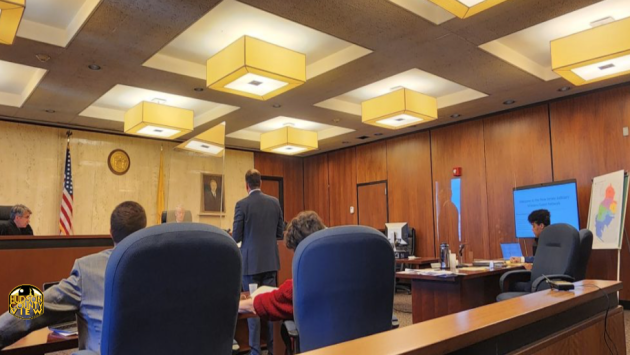The Superior Court of New Jersey Appellate Division heard arguments in the Jersey City ward map case that was dismissed by the lower court 15 months ago in Newark this morning.
By Daniel Ulloa/Hudson County View
The appellate court heard on two related cases: Jersey City United Against the New Ward Map vs. Jersey City Ward Commission and John Minella, as well as James Calderon vs.. City of Jersey City Ward Commission, John Minella Chairman, Sean J. Gallagher, Secretary, and Commissioners Daniel E. Beckelman, Paul Casteli, Janet Larwa, and Daniel Miquli.
Hudson County Superior Court Judge Joseph Turula dismissed the Jersey City United lawsuit with prejudice back in August of 2022, as HCV first reported.
Renee Steinhagen, of the NJ Appleseed Public Interest Center, was the attorney for the plaintiffs. She alleged the commission completely failed to consider compactness.
“The diagnostic mark of the gerrymandering is the noncompactness,” she declared.
“Do you contend compactness has a constant element?” asked Appellate Judge Patrick DeAlmeida asked.
“No. We have a statutory requirement for compactness. It depends on the interpretation,” Steinhagen replied, also that there is not a clear court definition of compactness and that the plaintiffs drew up their own map.
“We were able to cut the population deviation by half,” Steinhagen argued, later pointing out that the trial court did not try to define compactness.
“How do you propose compactness should be defined?” Appellate Judge Robert Gilson
asked.
“It’s closely united, density,” Steinhagen replied.
“There’s objective criteria? DeAlmeida questioned, prompting Steinhagen to cite a 1981 Plain language law that indicated it’s geographical.
Gilson said the court wanted to know exactly what the Jersey City Ward Commission got wrong, to which Steinhagen repeated that they did not consider compactness.
“We developed a theory this was done in retaliation to the election of Frank Gilmore, the only independent non-incumbent that won,” she declared.
“What evidence do we have of that? Allegations are not evidence,” Gilson asserted.
“The way they drew Ward F: They took out every single development project that Frank complained about,” Steinhagen explained.
“They excluded the whole opportunity zone for development that had previously been in F.”
She noted Gilmore held meetings against the projects that were taken out of the district, specifically SciTech Scity and Morris Canal Manor (both were moved to Ward A).
“Sounds like you’re speculating. What is it we can look into the record to see this?” Gilson asked.
“We have a map. It’s multi-sided and weird-shaped. Completely different communities of interest,” Steinhagen replied.
DeAlmeida then recalled that there was a different map that was going to be presented at a January 2022 meeting that was cancelled due to Zoom issues.
“A new map appears and was approved with no discussion with a lot of people screaming. People were outraged at the lack of transparency,” Steinhagen noted.
Appellate Court Judge Avis Bishop-Thompson said that while it was alleged that Gilmore was only given a copy of the map two days before the ward commission meeting, it appeared on social media before that.
“Other Council people received the map formally before that. He wasn’t given the map at the same time other Council people were given the map,” Steinhagen clarified.
“My concern is with the retaliation complaint: It’s less evident, it seems less clear how that would be proven,” DeAlmeida stated.
Steinhagen answered that 15,000 Black and Hispanic people were moved out of Ward F and about 14,700 caucasian people were brought in from Ward E, which cuts the population deviation in half.
She also contended that the Open Public Meetings Act was violated, as well as that the chair of the commission, John Minella, is Mayor Steven Fulop’s chief of staff and would therefore have political motivations against Gilmore.
“They used election districts for the first time: They did not use it in Hoboken … There’s been a substantive real harm,” Steinhagen added.
“We have a motion to dismiss. How do we say there’s evidence those wards are, in fact, compact?” Gilson asked Jason Orlando, a partner at Orlando Murphy LLC who is representing the city in the matter.
“There was explosive population growth in Jersey City, especially on the waterfront. 50,000 people moved in, so there was a significant deviation in districts,” he replied, adding that the map followed the “one man, one vote” law.
DeAlmeida contended that the final map was essentially decided on in secret, to which Orlando said there were closed working sessions that are permitted.
“Regardless of whether there was other maps, that’s immaterial,” Orlando argued.
“Does compactness stand on its own?” Dealmeida asked.
“This is compact,” Orlando argued.
“How do we know that?” Gilson questioned.
Orlando said it was dense and that compactness is elusive, along with that Liberty State Park warped the shape of the map.
“Isn’t a development proposed by the Liberty Science Center?” DeAlmeida asked.
“You’re getting into political considerations,” Orlando replied, later stating that OPMA largely didn’t apply here since there was rarely a quorum on these discussions.
Gilson said the map was adopted with little discussion.
“Did they come in with a consensus? You effectively violated the Open Public Meetings Act,” Gilson pressed on.
Undeterred, Orlando said the commission was permitted to consult with experts in a working session.
“This is supposed to be a transparent process so the communities impacted know exactly what’s going to happen,” Bishop-Thompson said.
“It was met here,” Orlando said.
“Plaintiffs have alleged the meeting scheduled for January 14th had a technical difficulty. Over 100 residents were complaining about this map. The next meeting was held on a Saturday morning during frigid temperatures. How was that not an Open Public Meetings Act violation?” Bishop-Thompson added.
Orlando said there was nothing nefarious going on, simply that it was winter time and it happened to be a cold day. The commission also had a 30-day obligation to fulfill.
“This wasn’t some sort of nefarious plot. It just happened to be a cold day,” Orlando said, further stating that there was no discrimination here.
Dealmeida noted election districts were used and removed based on voting patterns.
“Relying on election districts is wholly rational,” Orlando argued.
“So protecting incumbents is permissible?” DeAlmeida asked, to which Orlando said not all redistricting efforts protect incumbents.
“Redistricting at its core is a political process: It’s a valid map,” Orlando continued.
A short time late, Gilson asked what proof exists that the map being challenged violated the law.
“It has over 34 sides, our map moved 15,000 less people,” Steinhagen stated.
Gilson said a written opinion would be issued in the future before hearing from Calderon, he also claimed the current map is not compact.
“It has to be created on the record. F is a boomerang. A is a U. They violated the law by not making compact districts,” Calderon said.
“All that’s required is you publish the boundaries of the district,” Orlando asserted, noting that the two required public meetings were held.
Bishop-Thompson said that while there were public meetings, her understanding was that no actual discussion was had.
“The commissioners themselves didn’t discuss the map: What’s the purpose of the second meeting?” Gilson question.
Orlando said many bodies require votes without a substantial debate.
The appellate court did not put a timeline on when their written decision would be rendered.









